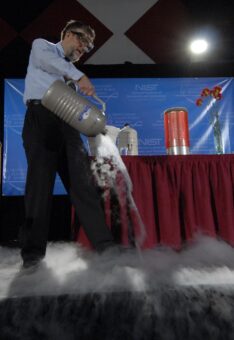
William D. Phillips
Distinguished University and College Park Professor of Physics, University of Maryland. NIST Fellow, National Institute of Standards and Technology
Charles M. and Martha Hitchcock Lectures
February 9, 2022 — 4:10 PMVirtual
Lecture Live Stream (below) or View Directly via YouTube About the lecture At the beginning of the 20th century Einstein changed the way we think about Time. Now, early in the 21st century, the measurement of Time is being revolutionized … Continued
Virtual - Berkeley Graduate Lectures [email protected] false MM/DD/YYYYLecture Live Stream (below) or View Directly via YouTube
About the lecture
At the beginning of the 20th century Einstein changed the way we think about Time. Now, early in the 21st century, the measurement of Time is being revolutionized by the ability to cool a gas of atoms to temperatures millions of times lower than any naturally occurring temperature in the universe. Atomic clocks, the best timekeepers ever made, are one of the scientific and technological wonders of modern life. Such super-accurate clocks are essential to industry, commerce, and science; they are the heart of the Global Positioning System (GPS), which guides cars, airplanes, and hikers to their destinations. Today, the best primary atomic clocks use ultracold atoms, achieve accuracies of about one second in 300 million years, while a new generation of atomic clocks is leading us to re-define what we mean by time. Super-cold atoms, with temperatures that can be below a billionth of a degree above absolute zero, use, and allow tests of, some of Einstein’s strangest predictions.
This will be a lively, multimedia presentation, including exciting experimental demonstrations and down-to-earth explanations about some of today’s hottest (and coolest) science.
About William D. Phillips
William D. Phillips received a B.S. in physics from Juniata College in 1970, and his Ph.D. from the Massachusetts Institute of Technology in 1976; after two years as a Chaim Weizmann postdoctoral fellow at MIT, he joined NIST (then the National Bureau of Standards) to work on precision electrical measurements and fundamental constants. There, he initiated a new research program to cool atomic gases with laser light. He founded NIST’s Laser Cooling and Trapping Group, and later was a founding member of the Joint Quantum Institute, a cooperative research organization of NIST and the University of Maryland that is devoted to the study of quantum coherent phenomena. His research group has been responsible for developing some of the main techniques now used for laser-cooling and cold-atom experiments in laboratories around the world.
Dr. Phillips is a fellow of the American Physical Society, the American Association for the Advancement of Science, and the American Academy of Arts and Sciences. He is a Fellow and Honorary Member of the Optical Society, a member of the National Academy of Sciences and the Pontifical Academy of Sciences, and a corresponding member of the Mexican Academy of Sciences. In 1997, Dr. Phillips shared the Nobel Prize in Physics “for development of methods to cool and trap atoms with laser light.”